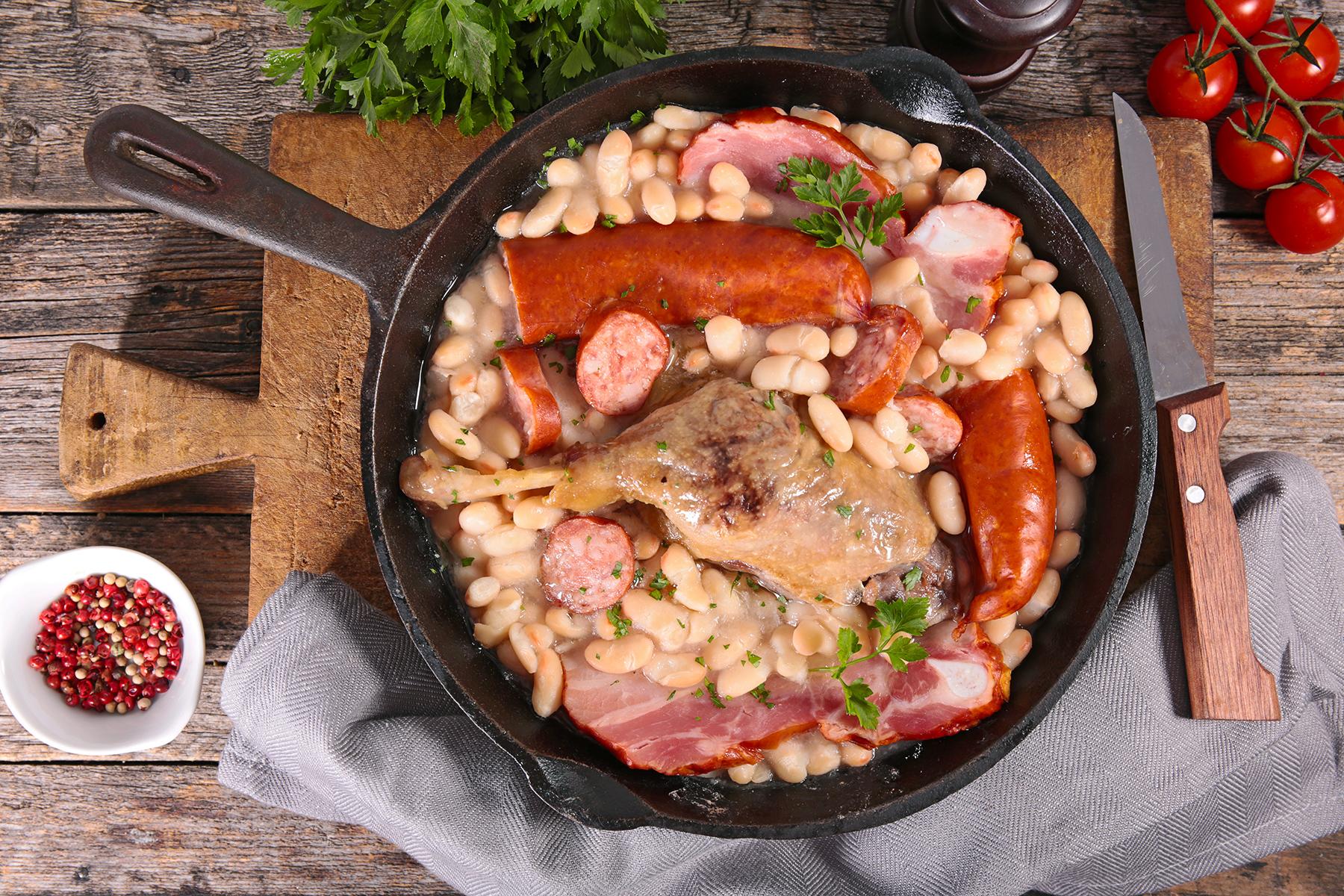These 16 emblematic dishes from all around the country show how rich and varied French cuisine really is.
Many visitors to France focus their gastronomic discovery to the capital city of Paris, but the rest of the country is just as rich with culinary marvels–if not more so. From escargots in Burgundy to crêpes in Brittany, each region has its own flavors, ingredients, and dishes to offer.
The unique cuisine of each region illustrates the French concept of terroir, an essential idea that governs the AOP designations that make it impossible to call any sparkling wine made outside of the Champagne region Champagne. Terroir is the belief that the way in which food is made is guided by the soil, the air, and the landscape of the region in which it is made: it’s a huge part of what makes France one of the world’s best destinations for foodies.
Top Picks for You
Breton Buckwheat Crêpes
WHERE: Saint-Malo, Brittany
Crêpes may be a popular street food snack throughout France these days, but they actually hail from Brittany, where wheat flour is used to make sweet crêpes and buckwheat flour is used to make savory galettes. Both are served at Saint-Malo’s Crêperie Margaux, which is known among locals for its beautiful outdoor terrace and unique fillings that surpass the usual ham-and-cheese. Smoked duck breast, pear, and blue cheese unite in the “Enzo,” while the “Jeff” is filled with scallops flambéed in whiskey and caramelized leeks, and the “Paul” features artisanal sausage, potatoes, and house-made mustard ice cream. For dessert, you can’t go wrong with Breton salted butter caramel: in the “Stella” the homemade sauce is paired with local butter cookies, ice cream, and whipped cream, all folded into a perfectly delicate crêpe.
INSIDER TIPAnother local Breton specialty is apple cider: unlike in the States, cider is always at least slightly alcoholic. At Crêperie Margaux, diners can choose among doux (sweet, and the least alcoholic of the bunch) brut (dry), demi-sec (half-dry), and even pink, each of which hails from a different artisanal producer.
Norman Omelette de la Mère Poulard
WHERE: Mont Saint-Michel, Normandy
Normandy is home to many of France’s most emblematic foods, most of them linked to its dairy industry: Norman butter, cream, and cheese are some of the best in France. Local butter is a key to the otherwise secret recipe for Mère Poulard’s puffy omelette, at once a legend and a restaurant on the island of Mont-Saint Michel. The omelettes here have been made to order in rustic copper pans since the 19th century and are available plain or filled with a variety of ingredients, including local Camembert. With a texture like soufflé and a rich, unctuous flavor, they’re an unmissable part of a visit to Mont Saint-Michel.
INSIDER TIPLa Mère Poulard also serves up dessert omelettes, including one filled with roasted apples and salted butter caramel and flambéed with Calvados apple brandy–you can’t get more Norman than that.
Recommended Fodor’s Video
Northern Carbonnade
WHERE: Lille, Nord
The cuisine of the North of France is far closer to that of Belgium, starting with the fact that while wine is the main beverage in most of the “hexagon,” in the North, beer takes center stage. It’s a key ingredient in carbonnade, a local stew of beef and rich amber beer. The version at the Estaminet au Vieux de la Vieille also includes local gingerbread for a slightly sweet flavor to offset the bitterness of the brew. This estaminet, a sort of restaurant or café typical of the North and Belgium, is known for its other Northern specialties as well, including fricandelle, a local sausage and cheese soup, which features a local Maroilles, a washed-rind cheese whose smell is certainly not for the faint of heart.
A True Tarte Tatin
WHERE: Lamotte-Beuvron, Centre
Tarte Tatin is an emblematic dish of the center of France, ostensibly invented here at the Hôtel Tatin when it was still run by sisters Caroline and Stephanie Tatin at the end of the 19th century. It was here that, according to legend, Stephanie Tatin forgot to place a pastry base beneath the caramelized apples of her famous apple tart one busy afternoon. Thinking quickly, Stephanie rolled out some dough and placed it on top of the apples, flipping the tart upside down only once it was baked. Return to the site of the crime and see for yourself why this quickly became a classic throughout France.
Alsatian Choucroute
WHERE: Strasbourg, Alsace
Alsace has historically linked France and Germany in both language and cuisine: the local terroir includes Gewürztraminer wine, pizza-like flammekueche featuring a crème fraîche and bacon topping, and choucroute, a hearty combination of sauerkraut and local charcuterie, seasoned with caraway and juniper. Au Coin des Pucelles is a traditional restaurant that serves up not only a fantastic choucroute but also a host of other local specialties.
INSIDER TIPDon’t miss the knepfles with munster; this Alsatian answer to mac and cheese combines handmade pasta with local washed-rind cheese.
Quiche Lorraine
WHERE: Metz, Lorraine
It’s no surprise that the Lorraine region is famous for its quiche: while generally considered to be a French specialty, these savory tarts actually get their name from the German kuchen, meaning cake, and were invented in German Lothringen–now French Lorraine–during the Middle Ages. Fans of quiche Lorraine have different points of view as to what is allowed in the dish: some add onions and/or cheese, while others claim this is sacrilege. Brasserie Flo in Metz serves up a great version of the classic with ham and cheese in a flaky pie crust.
Burgundian Escargots
WHERE: Beaune, Bourgogne
Burgundy is of course known, first and foremost, for its wine. But a close second are the escargots à la bourguignonne: the snails broiled in a heavenly garlic and parsley butter that you’ll find on nearly every Parisian menu. To try some of the best, however, go straight to the source: this shop in Beaune not only sells everything you could ever want to make escargots at home, but they’ll also prepare and serve a dozen snails to order–to be enjoyed with a glass of white wine, bien sûr.
Auvergnat Truffade
WHERE: Mazayes, Auvergne
The Auvergne region is known for its delicious charcuterie and cheese, but also for its hearty winter fare: the Auberge de Mazayes offers a typical local ambiance in which to sample local delicacies, including truffade, a luscious combination of local hard cheese and potatoes with just a hint of garlic: the perfect way to get up your strength for a hike through the (inactive) Auvergne volcanoes.
Lamproie à la Bordelaise
WHERE: Bordeaux, Aquitaine
Bordeaux is known for its wine, but it’s also known for its southwestern cuisine: surf and turf mix naturally here, with local oysters and local beef equally comfortable on traditional menus. The Brasserie Bordelaise, with its keen attention to quality, serves up quite a few local specialties, including lamprey eels in red wine sauce–a typical Aquitaine recipe. The fish is stewed in a rich Bordeaux sauce and served with house-made potato puree.
Alpine Raclette
WHERE: Grenoble, Rhône Alpes
Cheese specialties like fondue are more closely associated with Swiss cuisine, but the French Alps know how to do them up right as well. At La Ferme à Dédé, cheese fondue but also raclette–an interactive dish whereby the eponymous cheese is melted on an apparatus and scraped onto cooked potatoes and charcuterie–are the stars of the menu. Tartiflette is another great choice: this baked dish includes potatoes, bacon, cream, and melted reblochon cheese.
INSIDER TIPGrenoble is also home to one of the only AOP-protected fruits: the Grenoble walnut. Try it out at La Ferme à Dédé in a delicious salad or as a sauce atop homemade ravioli.
Lyonnais Andouillette
WHERE: Lyon, Rhône Alpes
While some think of Paris as the culinary capital of France, in reality, Paris doesn’t hold a candle to Lyon. The southern city’s rich culinary culture is best experienced at the bouchon, a local style of restaurant where ambiance and copious amounts of delicious, traditional food are on the menu. At the Tête de Lard, sample exquisite versions of a host of local dishes including calf’s head, tongue in vinegar sauce, and andouillette–a sort of offal sausage that’s quite divisive, given its strong smell. Those who like andouillette tend to defend it quite vociferously–there’s even an association for andouillette-lovers called the Association amicale des amateurs d’andouillettes authentiques (the Friendly Association of Lovers of Authentic Andouillette) that rewards the best andouillettes with an AAAAA certificate.
Niçois Socca
WHERE: Nice, Provence-Alpes-Côte-d’Azur
When you think of Nice, you may first think of the eponymous salade niçoise featuring tuna, anchovies, tomatoes, olives, and potatoes. But Nice is also known for socca, a sort of chickpea flour pancake that Chez Pipo has been making and serving since 1923. Seeing as socca takes a bit of time to get perfectly cooked, it sometimes demands a bit of a wait, here; order some of the delicious tartinades, or local dips, while you wait, and don’t forget to top your socca with black pepper before digging in.
INSIDER TIPWhile Chez Pipo is known for its socca, it also serves up a host of other traditional Niçois specialties, including pissaladière, a sort of pizza topped with caramelized onions, olives, and anchovies.
Marseillais Bouillabaisse
WHERE: Marseille, Provence-Alpes-Côte-d’Azur
Port city Marseille’s most famous dish is undoubtedly bouillabaisse, the hearty seafood stew that fishermen used to make with a hodgepodge of whatever fresh fish they couldn’t sell. While each Marseillais has his or her own recipe, the one at Chez Michel is a surefire winner: this “bouillabaisse specialist” has been cooking up the stew since 1946. A waiter will bring out your fish to be inspected before it goes into the pot to be cooked, and he’ll also show you the traditional way of enjoying all the elements: cooked fish, broth, toast, and rouille garlic spread.
INSIDER TIPSince the bouillabaisse is cooked to order here, it may take a while: consider some deep-fried squid as an appetizer to tide you over while you wait.
Toulouse Cassoulet
WHERE: Toulouse, Occitanie
Depending on who you ask, the famous southern dish of cassoulet could come either from Toulouse, Carcassonne, or Castelnaudary. A rich, hearty bean-based dish perfect for winter, cassoulet is so popular in the region that there is a “cassoulet belt” connecting these cities with a smattering of other towns that also cook up delicious versions. Cassoulet fans will likely want to try at least three different versions of the dish, but don’t miss the one at Le Colombier in Toulouse. Here, long-stewed lingot beans are cooked with sausage, pork, goose, and a touch of tomato purée, which makes the Toulousain version stand out from the crowd.
Corsican Braised Mutton
WHERE: Pigna, Corsica
Corsican cuisine is based heavily in the products of the region, including chestnuts, sheep’s milk cheese, lamb, and fresh herbs. Slow-cooked braised or barbecued meats are common, like the brebis à l’antica served at the A Mandria di Pigna restaurant. This stewed mutton dish is cooked for seven hours with local herbs and local wine, for a meal that evokes the true flavors of Corsica.
Basque Txuleta and Cider
WHERE: Bayonne, Basque Country
The Basque Country is known for so many culinary specialties, it’s hard to pick just one. The region straddles the Franco-Spanish border, with a history, culture, and language that predate those of either France or Spain. While you should definitely try pintxos, or Basque tapas, and Basque cake, you’d be remiss not to sample txuleta, beef rib chops–the classic dish served at Basque cider houses. At Cidrerie Ttipia, the traditional dining room contains the typical wooden barrels of cider, from which diners are encouraged to serve themselves.
INSIDER TIPGo with a crowd if you can–half the fun of visiting a Basque cider house is the ambiance. When someone in the room shouts “Txotx!” you’re supposed to jump up, fill your glass with cider, and drink.





